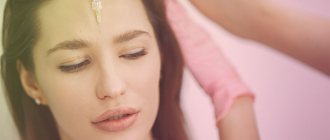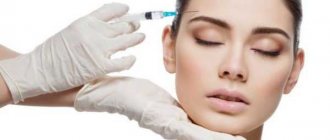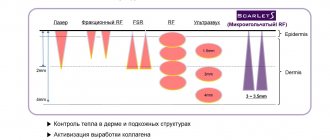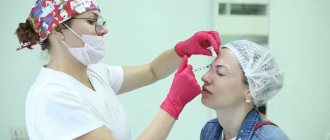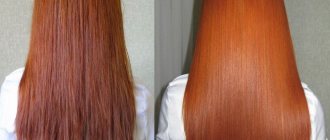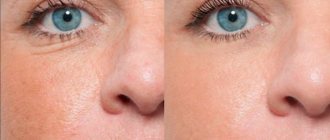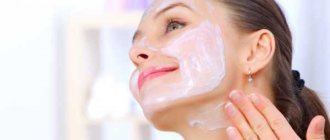Age threshold
There are minimum and maximum thresholds for the use of Botox.
Minimum
It is believed that Botox can be injected into a child when he reaches the age of three. At such an early age, injections are given for medical reasons. Botoxotherapy is prescribed for some neurological diseases:
- strabismus;
- with cerebral palsy;
- cervical dystonia and other diseases.
Previously, the minimum age was 12 years, because... It was believed that using Botox at an early age was dangerous. After careful consideration, the age limit was lowered to three years. But permission to use Botox can only be given by the attending physician, having studied all the possible risks.
For cosmetic purposes, Botox is recommended for people over the age of eighteen, although the skin at this age is very elastic and the Botox procedure is not particularly required. Typically, the need to restore youth and eliminate wrinkles arises at the age of 25.
Maximum
It is also believed that the use of Botox after 60 years is not recommended, or, more simply, contraindicated. The result at this age may be exactly the opposite of what was expected and facial asymmetry may appear, so advanced age is a contraindication for the procedure.
A visit to a cosmetologist is recommended only after consulting a specialist, because This procedure is contraindicated for many chronic diseases.
It's a young thing: Botox injections up to 30 years old
Expression wrinkles
can appear even at a very young age. To prevent them from turning into sad static creases, cosmetologists suggest being proactive. But without fanaticism! We understand the intricacies of Botox injections up to 30 years.
Injections of botulinum toxin type A (BTA), known to everyone as Botox, are the “gold standard” in eliminating expression lines. Today even very young people – 18–30 year olds – are turning to this influence. In reality, passport age does not play a special role. A much more important parameter is the individual structure and dynamics of facial muscles.
Speaking in medical language, botulinum therapy is a procedure for neuromuscular denervation, that is, temporary relaxation of certain facial muscles. Experienced doctors perform injections very skillfully, without significantly affecting the contractility of the facial muscles and, therefore, without immobilizing the face. By the way, botulinum therapy may well contribute to the formation of a habit of other ways of expressing emotions than frowning eyebrows and a wrinkled forehead. Some people only need a couple of sessions to stop making faces and begin to control their facial expressions.
Botox is a cure for more than just wrinkles. Young people justifiably resort to this effect to eliminate slight facial asymmetry (for example, when one eyebrow is slightly lower than the other); correct a gingival smile, in which the upper gum is excessively exposed; solve the problem of hypertonicity of the masticatory muscles.
When can Botox injections be performed?
With all the advantages of botulinum therapy, it is worth warning: the procedure should be carried out only if there are objective indications. It is not so uncommon when young women want to “get Botox” as a fashion statement, and not out of real necessity. The desire to fight non-existent wrinkles may be a sign of dysmorphophobia - a pathological rejection of one’s own appearance, which requires the help of a psychotherapist, not a cosmetologist.
It would seem that Botox injections are a completely ordinary beauty manipulation, but, as with any aesthetic intervention, it is important not to miss a specialist. Before taking a syringe, the doctor must carefully assess the structure of the small facial muscles and the characteristics of the patient’s facial activity. And if a person undergoes such a procedure for the first time, the doctor is obliged to “calculate” the effect of the injections in the long term, to foresee how the person will “behave.” A cosmetologist has a responsible task: to influence the muscles so that the entire muscular “architecture” of the face is in fine balance and you look natural.
What are the features of Botox injections at a young age?
Botulinum toxin injections at the ages of 18–25 and 35–50 years differ both in indications and in the protocol for performing the procedure. If in patients over 35 the treatment area can be quite extensive (forehead, between the eyebrows, the back of the nose, the area around the eyes, the area of the upper lip (for the purpose of correcting purse-string wrinkles), the corners of the mouth, the edge of the lower jaw, neck), then in 20-year-olds The focus of attention is usually only the upper third of the face (forehead, eyebrow area, area around the eyes).
Complications of botulinum therapy of the upper third of the face? If dosed incorrectly or injected into the “wrong” place, botulinum toxin can cause, for example, drooping eyelids.
Fortunately, adverse events are reversible, and over more than 20 years of practice and research they have been minimized. In addition, in young people these risks are significantly lower due to good muscle tone, elastic skin and full microcirculation in the tissues.
The dosage of botulinum toxin (as well as the choice of technique for its administration) is individual. For example, a young man (members of the stronger sex today quite readily turn to botulinum therapy) with active facial expressions and developed facial muscles will most likely need a dose of the drug 40–50% higher than a woman of the same age. Young women usually require fewer injections than older women.
From dreams to reality?
Despite the fact that many of us can easily endure an injection of botulinum toxin for the sake of beauty, we continue to dream of cosmetics with the Botox effect. And it seems that it’s not in vain! Two American companies are now in full swing testing Botox-type gels for application to the skin in the most common way - as a skincare product! Is there really going to be a breakthrough?
These beauty products may become available to the public as early as 2019. Researchers and doctors are optimistic. Yes, the skin barrier still remains an obstacle to the “cosmetic” botulinum toxin, but it still allows it to pass through in sufficient quantities to smooth out the “crow’s feet” around the eyes (while we are talking about the cosmetic correction of these particular wrinkles). Special peptides transport botulinum toxin to the right place. In terms of the power of impact, the cosmetic novelty is inferior to injections, but, according to preliminary data, the result of its use is still noticeably pronounced, and its duration reaches three months!
Expert opinion
Taisa Generalova,
dermatocosmetologist at the aesthetic medicine clinic “ONI clinic”
If the doctor sees that facial expressions are quite active and wrinkles may become more pronounced in the future, botulinum toxin injections can be used from the age of 25 or even earlier. As a result of injections, we in no case completely turn off the muscle from movement forever, but only temporarily block muscle activity.
Which specific botulinum toxin preparation to use - for example, Botox or Dysport - is not of fundamental importance, since the active ingredient in the formula is the same. Concentrations in modern drugs are carefully verified and are optimal in terms of safety and effectiveness. Therefore, you should not initially “tune in” to a specific brand. Although it happens that, due to the individual characteristics of the patient, the effect of one solution lasts slightly longer than the other. But this can only be verified in practice. Can moisturizing treatments and biorevitalization be called an alternative to botulinum therapy? No. These effects improve the quality of the skin, but do not affect the activity of the facial muscles - the cause of facial wrinkles.
Limit on number of procedures
There are no strict restrictions on the number of procedures for different ages. The results of the injections become noticeable within a few days, and the effect remains for several months. The results of Botox injections vary from person to person due to a number of reasons, and the need for repeat procedures also varies. Firstly, clients’ lifestyle influences: smoking and alcohol make them visit the clinic more often. Athletes are emotional people, so they also resort to procedures more often.
If the result is shorter in duration than expected, the procedure can be repeated no earlier than four months later. This is due to the fact that botulinum toxin still has harmful effects on the body.
Hyaluronic acid: who needs volume replenishment
This is especially true for the now fashionable “volume replenishment” with the help of fillers based on hyaluronic acid, which are placed in the cheekbones or “pumped up” in the lips. Some cosmetologists recommend doing this “in reserve.” I believe that until degradation begins, until the body begins to spend its reserves and its own volumes begin to decrease, there is no need to “replenish” them. You can live without injections.
For the average woman who lives in a big city, has children, a job, “average” heredity and one or two bad habits, signs of aging appear on her face by the age of 35 . And at this time they can begin to be corrected using injections.
The older we get, the more reasons and reasons we have to resort to injections. But the golden rule of medicine remains golden: go from smaller to larger trauma and from smaller to larger. There is no need to immediately experiment with large doses and radical changes.
There comes a time when not only fat, but also bone tissue of the face disappears. Bones become thinner. And at this stage, increasing the volume of the cheekbones or strengthening the brow ridge is completely justified. It will be beautiful.
But when an additional one is added to the existing volume - for the purpose of "prevention" or because the client is ready to pay, and the cosmetologist wants to earn extra money - it doesn't turn out very nice.
Yes, there are isolated cases when the diagnosis of “emaciated face” can be given to a young person. And, of course, then it would be better for him to inject fillers. But this rarely happens.
What not to do AFTER Botox
How long should you drink alcohol after Botox?
Today, alcohol is allowed after Botox.
There was a ban on alcohol consumption, but it was lifted several years ago. Although some are still not in the know, and some of our cosmetologist friends know, but don’t tell their friends - they are fighting for sobriety in this way 
We believe that our patients are adults and will figure out how much and when to drink.
How long can you not exercise after Botox?
This is a more complicated question, because sport is different from sport. Therefore, expert opinions vary slightly. You can warm up lightly the very next day, it’s better to postpone serious training for 2-3 days (what is light and where is the borderline of serious - decide for yourself 
Is it possible to sunbathe after Botox?
Let's be honest - it's a confusing question. There is little scientific data on this topic. There are still statements like “Dysport and solarium are incompatible,” but there have been no serious justifications for this.
Previously, sunbathing was strictly prohibited for 1-2 weeks, then the period was reduced. Then they argued whether it was necessary to cover the face when tanning or whether it didn’t matter.
So far we have settled on a limit of 2-3 days completely and another 2-3 days without a face.
But we remember the recommendation not to lie for 2 hours (horizontal tanning beds), and not to heat the area where Botox is applied in the first week - if the turbo solarium is hot, we cover our face.
Can I wash my hair after Botox?
Can. And wash completely too. Just don’t take hot baths in the first 3 days.
Is it possible to do biorevitalization after Botox?
It is possible, with a few reservations. It’s better, of course, to space the procedures out over a week and let everyone sleep peacefully, but sometimes there’s no time.
- Ideally, space out the procedures by at least 1 day and do not inject hyaluronic acid into the areas where Botox was placed.
- Not doing this with a patient for the first time is rare, but there are atypical reactions, and in this case you will have to guess what it is from. If the patient has already tried Botox and hyaluronic acid before, you can be more or less calm.
- Today, biorevitalizants can be called different drugs containing not only pure hyaluronic acid - they need to be dealt with separately. The same applies to mesotherapy - you need to clarify the composition of the drug.
Is Botox possible after biorevitalization?
You can, see the previous paragraph.
If a biorevitalizant is still placed in the areas where Botox needs to be applied, then it is better to wait until all visible reactions from it go away - papules, redness, swelling, etc.
Botox and sauna, dysport and bath
In the first 5-7 days it is better to abstain.
It is clear that everyone steams differently, so it is difficult to derive a strict pattern, but there are observations that significant heating of surface tissues can lead to a rapid elimination of the effect of botulinum toxins. And for those who go to the sauna weekly and like more heat, Botox generally costs less.
Therefore, if you want, you can, but you need to be prepared for the most frequent repetitions of procedures. And steaming in a hat is, by the way, a must even without Botox.
Can I take antibiotics after Botox?
The issue is not antibiotics at all, but health. Antibiotics are not prescribed just like that - there are always specific, compelling reasons for their use. If a person gets sick and needs treatment, then it doesn’t matter what happens to the Botox that was given - it will last a little longer, and it needs to be treated a little less.
Another thing is that we often take antibiotics not according to indications - but this is not the case in any case, and Botox has nothing to do with it.
When can you take antibiotics after Botox?
As soon as their use became necessary. If this is an acute infectious disease and there are indications for antibacterial therapy, we begin treatment without regard to Botox. If this is something chronic or some kind of preventive treatment (sometimes they are also needed) and time is waiting, and an antibiotic is definitely needed from the “Botox” group (aminoglycosides, macrolides, tetracyclines, polymyxins), then just in case you can wait a week.
How long after Botox can I peel?
Peeling and peeling are different. Light superficial peelings even the next day.
Serious medians - after passing the staged reaction. If you have very little time, wait at least 5 days and you can do it.
But you need to take into account that peelings activate metabolic processes in the skin, and partly in the tissues adjacent to the skin. And they can (theoretically) shorten the duration of the Botox effect. We have never seen Botox go away completely after peeling, but still. Therefore, if the procedures are not done under time pressure, but are planned in advance, then it is more correct to do peeling first, and only then Botox.
How to sleep after Botox?
Sleep as comfortably as possible, but lying down 2 hours after the procedure is not recommended.
Is it possible to massage your face after Botox?
Opinions on this issue vary slightly. Nowadays, most authorities allow massage after 2 weeks after Botox has been applied to the face, some even earlier.
There are no restrictions at all in the treatment of hyperhidrosis.
Is it possible to massage the body after Botox?
Can. And regular massage, and anti-cellulite, and hardware LPG, etc. - 2 hours have passed and do your best.
